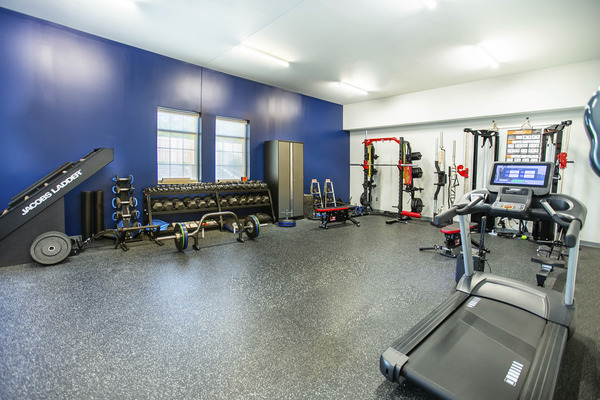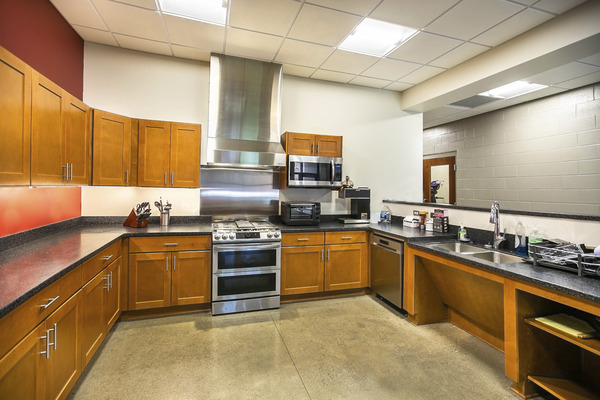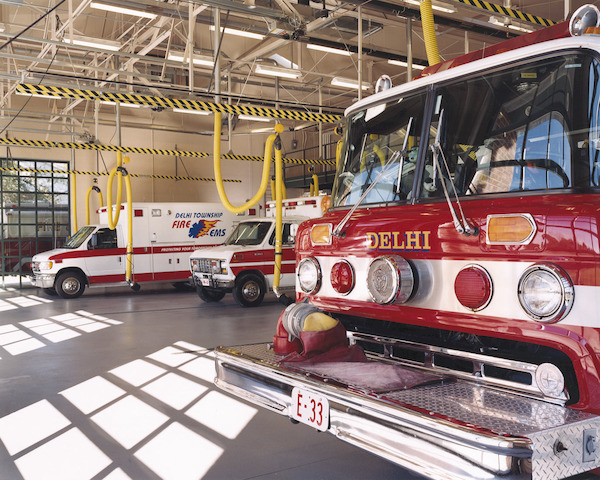Firefighting is a high-stress, physical occupation. It may be obvious that firefighters need to maintain their physical fitness; health and wellbeing for firefighters goes beyond strength and stamina. Firefighting is undoubtedly a high stress and high-risk occupation. Over the course of their career, firefighters statistically have higher rates of cancer and heart attacks; increased mental health issues such as stress, depression, and PTSD; and a potentially lower life expectancy than the general population. As designers, we can help create fire stations that can inherently support firefighters’ physical and mental health and wellbeing.
Physical Fitness & Preventative Health
The demands of firefighting require physical fitness. Firefighters donning turn out gear alone carry as much as 45 pounds of weight. SCBA (Self-Contained Breathing Apparatus,) radios, tools, lights, and other equipment can double that. NFPA 1582 sets standards for firefighter fitness, including aerobic capacity; BMI; grip, leg, and arm strength; muscular endurance, and flexibility. High blood pressure, diabetes, and heart attacks are frequent causes of illness and even death for firefighters. Many of these issues are tied to physical fitness.

Fitness facilities in firehouses have generally become givens, allowing firefighters to train in a variety of ways. Best practices include machines for specific strength exercises; treadmills, ellipticals, and Jacob’s ladders for cardiovascular and aerobic training as well as increasing strength and muscular endurance; and open areas for free weights, resistance training, and programs like HIIT, Tabata, and even yoga. Also, access from fitness areas to the outdoors can not only enhance the mental experience of a workout but can provide opportunities for running, CrossFit, and other activities that benefit from the open outdoors.
Research has also shown that firefighters have a higher risk of cancer diagnosis and increase in cancer-related deaths than the general U.S. population. While gear, equipment, and policies & procedures, such as using PPE and proper decontamination techniques, can mitigate physical risks and increase firefighter health, passive measures incorporated within firehouse design are important in reducing exposure to harmful gases, chemicals, and carcinogens. Although “clean on the scene” decontamination is an effective way to reduce bringing contaminants back to a station, thorough cleaning of gear, equipment, and apparatus is often impracticable in the field. Equipment, tools, and vehicles returning to the station often bring contaminants with them.
As an important first step in mitigating exposure to these and other contaminants within a firehouse, “hot zone” design strategies began to be commonly incorporated in station design within the last decade. In essence, this design strategy creates transitions and buffers between cold zones, clean spaces such as day rooms, kitchens, dining areas, bunk rooms, offices, etc., and hot zones, or areas with potential exposure such as apparatus bays, equipment storage, turn out gear storage rooms Vestibules, decontamination rooms, and other transition spaces are complemented by HVAC strategies (positive air pressure in clean zones and negative air pressures/exhaust in high-risk areas) to reduce the risk of contaminants and carcinogens entering areas where firefighters eat, work, and sleep.

Promoting Quality Sleep
Research shows that our physical and mental health are linked to our ability to experience circadian rhythms, the natural cycles of the day. The amount, timing, and quality of daylight that we experience not only affect our bodies’ physiology, but they also affect our alertness and sleep. Disruptions to our awareness of these cycles affect our bodies and our minds.
Unfortunately, firefighters often experience sleep disruption, exposure to artificial lighting at night, and other factors that conflict with their circadian rhythms. Sleep disruption and fatigue have both short- and long-term health consequences. Sleep deprivation among firefighters can lead to increased cardiovascular disease, diabetes, depression, and anxiety disorders when compared with the general public.
Fatigue also affects cognitive capacity and decision-making abilities, which are obvious risks that should be avoided in emergency situations. While short term lack of sleep may not create unacceptable levels of risk, extended sleep disturbances and sleep deprivation can not only be harmful to the individual’s health and wellbeing, but the effects on cognitive abilities may also create unfavorable outcomes for others.
Creating environments conducive to quality sleep is extremely beneficial to firefighters’ overall physical and mental health. Private bunk rooms and single-user restrooms allow individuals to better control their sleep environment and reduce disruption by other personnel. Dimmable lighting at night, sound masking, and individual control of temperature and air flow can also support better sleep. And while the function of alerting systems is critical in fire facilities, the sudden shock of calls can be reduced with alarm tones and lights that start small and increase slowly to alert firefighters. The use of graduated lighting along pathways from bunk rooms to bays also allows firefighters to adjust to waking as they progress to their gear and apparatus.
Mental and Emotional Wellbeing
The stresses associated with emergency situations directly affect firefighters’ health and well-being. Firefighters experience significantly more physically, mentally, and emotionally intense situations throughout their careers than the average person sees in their lifetime. The stress of these incidents can build over time resulting in higher rates of PTSD, depression, and suicidal thoughts among first responders.
With careful planning and thoughtful design strategies, environments that support firefighters’ mental and emotional wellbeing can be incorporated in firehouse design. Spaces that rest a firefighter’s mind and body as well as features that rejuvenate the spirit should be essential features in firehouses.
Access to daylight and views provides a connection to the outdoors and the natural environment. There is ample evidence that building occupants prefer spaces with windows. Daylight and views provide a sense of time and support the body’s natural circadian rhythms. Studies have shown that exposure to sights and sounds of nature, including daylight, flora, and fauna, can significantly improve mental and physical health recovery.

In addition to providing outdoor spaces for respite, views of nature and the sky from a window, the use of natural materials, incorporating organic forms and patterns in room finishes, using earth-tones and soft lighting, or even indoor plants can fulfil our innate biophilia, the human affinity for nature. About 90% of workers reported improved well-being in spaces with biophilic elements. Similar studies in medical facilities demonstrated increased energy, stamina, and focus while reducing blood-pressure, stress, anxiety, and depression.
